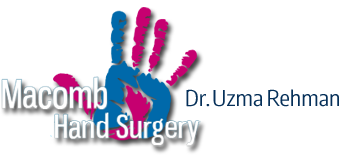Most Common Tennis Injuries of the Hand, Arm, Wrist & Shoulder
Spring has sprung in Michigan, the weather is finally warming up (well, some days), and tennis season is in full swing! College tennis culminates in May with the National Playoffs, but recreational tennis players will keep hitting the courts as long as fickle Michigan weather permits.
But whether you are a student athlete, a tennis pro, or an amateur enthusiast, tennis is a physically demanding sport. And with strenuous activities comes sports injuries.
Injury rates for junior competitive tennis players are estimated to range from 0.6 to 1.7 injuries for every 1,000 hours of tennis played. For professional adult tennis players, the injury rate is even higher, ranging from 2 to 6 injuries for every 1,000 hours of tennis played. At the championship level, according to a study published in the British Journal of Sports Medicine, injury rates are slightly lower for male tennis players, with 17.7 injuries per 1000 sets played. While female tennis players suffered 23.4 injuries per 1000 sets played.
And, according to the American Orthopedic Society for Sports Medicine, roughly two-thirds of tennis injuries are the result of overuse, while the remaining one-third tennis injuries are cause by traumatic or acute events.
The Most Common Tennis Injuries
Tennis Elbow
Tennis elbow is a painful condition that results from overuse of the muscles that extend and bend the wrist. The condition develops over time as the muscles are repeatedly impacted when the tennis ball hits the racquet. Both overuse their forearm muscles, as well as improper hitting techniques, can lead to tennis elbow pain.
Tennis elbow is the most common tennis injury, and even greats like Venus Williams, Bjorn Borg, Aleksandra Wozniak, Andy Murray and Juan Martin Del Potro have all suffered from it.
Tennis Shoulder Injuries (Bursitis)
Tennis players also run the risk of shoulder pain due to repeated stress on the shoulder joint during tennis strokes or caused by poor strengthening of the rotator cuff muscles. Overuse of the rotator cuff muscles during swings and hits can impinge the fluid-filled sac (“bursa”) between the shoulder’s bones and muscles. This results in inflammation and pain when the tennis player raises their arm – a condition called shoulder “bursitis”.
Symptoms of tennis elbow include pain or burning on the outside of the elbow, along with a weakened grip, as well as weakening of the forearm(s).
Stress Fracture Tennis Injuries
A stress fracture is a small crack in a bone, which is caused by repetitive movements or overuse. Tennis players typically suffer stress fractures from training too fast, which tires the muscles and puts more pressure on the bone.
Stress fractures are estimated to affect 7.5% of professional tennis players and 20% of junior tennis players.
Tennis Muscle Strains
Muscle strains are among the most common injuries to tennis players. Muscle strains happen to tennis players due to quick, sudden movements. Stretching and proper warm-ups are the best way to avoid muscles strains during tennis matches.
Torn Rotator Cuff
The rotator cuff is comprised of the muscles and tendons that hold the shoulder in place. The rotator cuff can become torn due to a sudden, acute injury. However, a tear in the rotator cuff can also develop with use or overuse over time.
Because the shoulder is used so much in everyday life, the rotator cuff naturally begins to wear down. But with the exertion of the shoulders during tennis practices and matches, the rotator cuff will naturally wear away even more.
Symptoms of a torn rotator cuff, include feeling extremely weak in the shoulder, tenderness in the shoulder, and difficulty maneuvering or lifting the arms.
Treating Tennis Injuries
The goal of any tennis injury treatment is allowing the injured body part to heal, so that there are no long-term effects, and the patient can return to normal activities (including playing tennis) without pain or limitations. Physical and occupational therapy can be crucial to helping tennis injury patients restore mobility and mitigate pain.
In some cases, cortisone injections can be used to reduce inflammation as well. And patients can also be fitted with arm and shoulder braces that support the joints during movements.
Fortunately, through dedicated physical and occupational therapy, most tennis players can be rehabilitated and return to the court. Additionally, attention to proper tennis techniques – as well as adequate warm ups and stretching – can help keep tennis players injury free after completing therapy.
In cases of more extensive tennis injury, however, a “sports medicine” PT/OT approach may not be sufficient – in which case surgery may be the next step. When surgery is required, it is essential to choose a board-certified surgeon, like Dr. Uzma Rehman, who has years of skill and experience treating tennis and other sports injuries.
Tendon debridement and release surgery, arthroscopic surgical repair, and other advanced surgery techniques can be performed by a board-certified surgeon to treat tennis injuries, preserve mobility, restore range of motion, and reduce pain.
Top Tennis Injury Surgeon & PT | Detroit Area
If you are suffering from a tennis injury or pain in your fingers, wrist, elbow, arm, or shoulder contact top board-certified Detroit area hand surgeon Dr. Uzma Rehman. She will offer you a comprehensive evaluation, diagnosis and consultation – and prescribe the most advanced treatments, sports medicine therapies, or surgeries that are best for your condition.
As with any sports injury, early detection, awareness, treatment, and therapy is the most effective way to ensure you are not permanently sidelined by your tennis injury. If you have a tennis injury, Dr. Rehman will reduce your pain and restore your mobility – so you will be back on the tennis courts as soon as possible!

